Healthcare Coverage Plans, Reimbursements, and Quality
VerifiedAdded on 2022/12/27
|7
|1514
|60
Report
AI Summary
This report provides an overview of healthcare coverage in the United States, focusing on Medicare and Medicaid as major national health insurance programs. It discusses the significance of health insurance in avoiding financial burdens and enhancing access to care, particularly for vulnerable populations. The report explores care options that both facilitate and limit patient access within Medicare and Medicaid. It also explains the function of Diagnosis Related Groups (DRGs) in standardizing hospital payments and the role of charity care in providing medical services to low-income individuals. The analysis emphasizes the importance of healthcare coverage in promoting community health and well-being. The report uses the Patient Protection and Affordable Care Act (PPACA) as a key policy example in US healthcare. This paper also discusses the role of charity care and the impact of the programs on patient access.
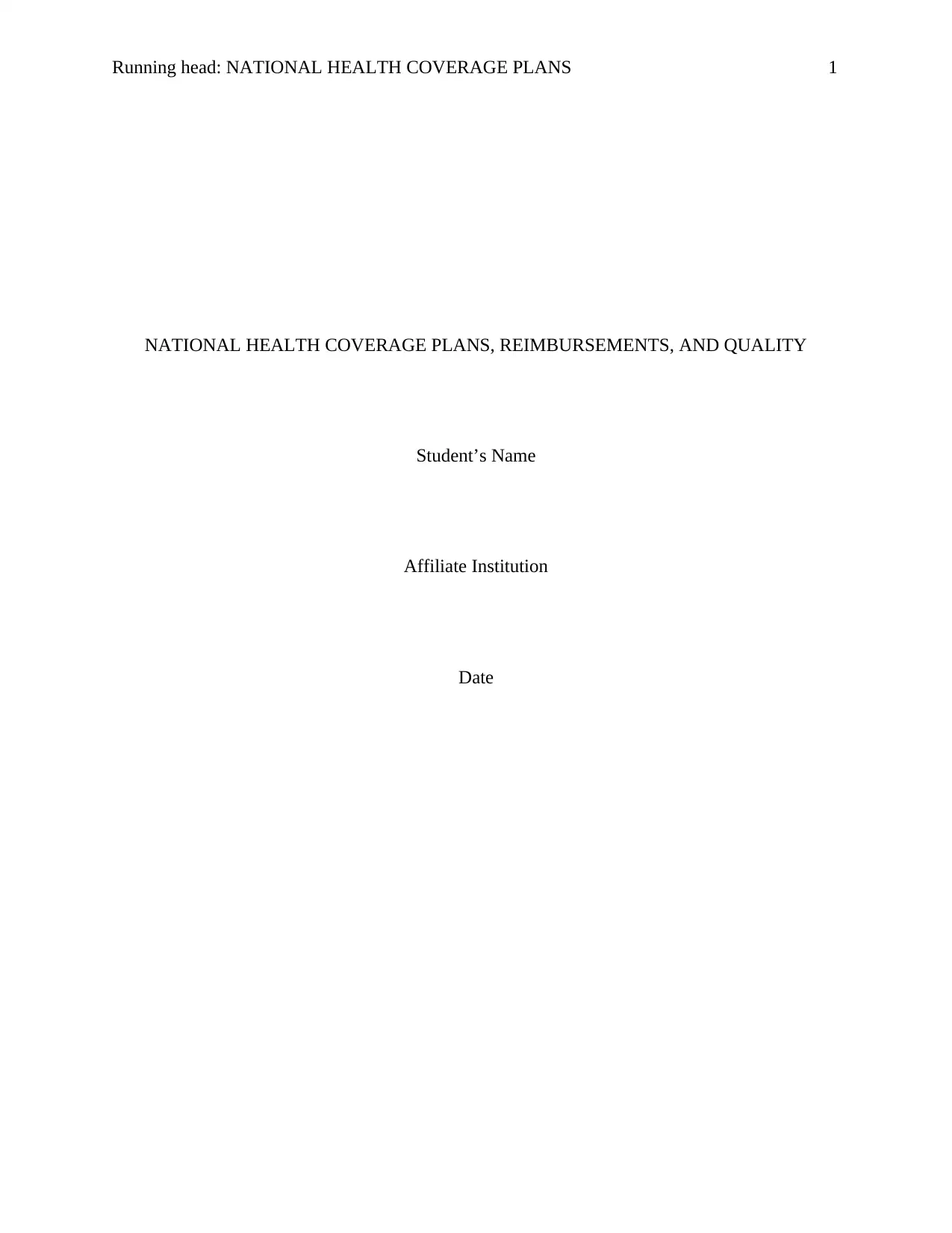
Running head: NATIONAL HEALTH COVERAGE PLANS 1
NATIONAL HEALTH COVERAGE PLANS, REIMBURSEMENTS, AND QUALITY
Student’s Name
Affiliate Institution
Date
NATIONAL HEALTH COVERAGE PLANS, REIMBURSEMENTS, AND QUALITY
Student’s Name
Affiliate Institution
Date
Paraphrase This Document
Need a fresh take? Get an instant paraphrase of this document with our AI Paraphraser
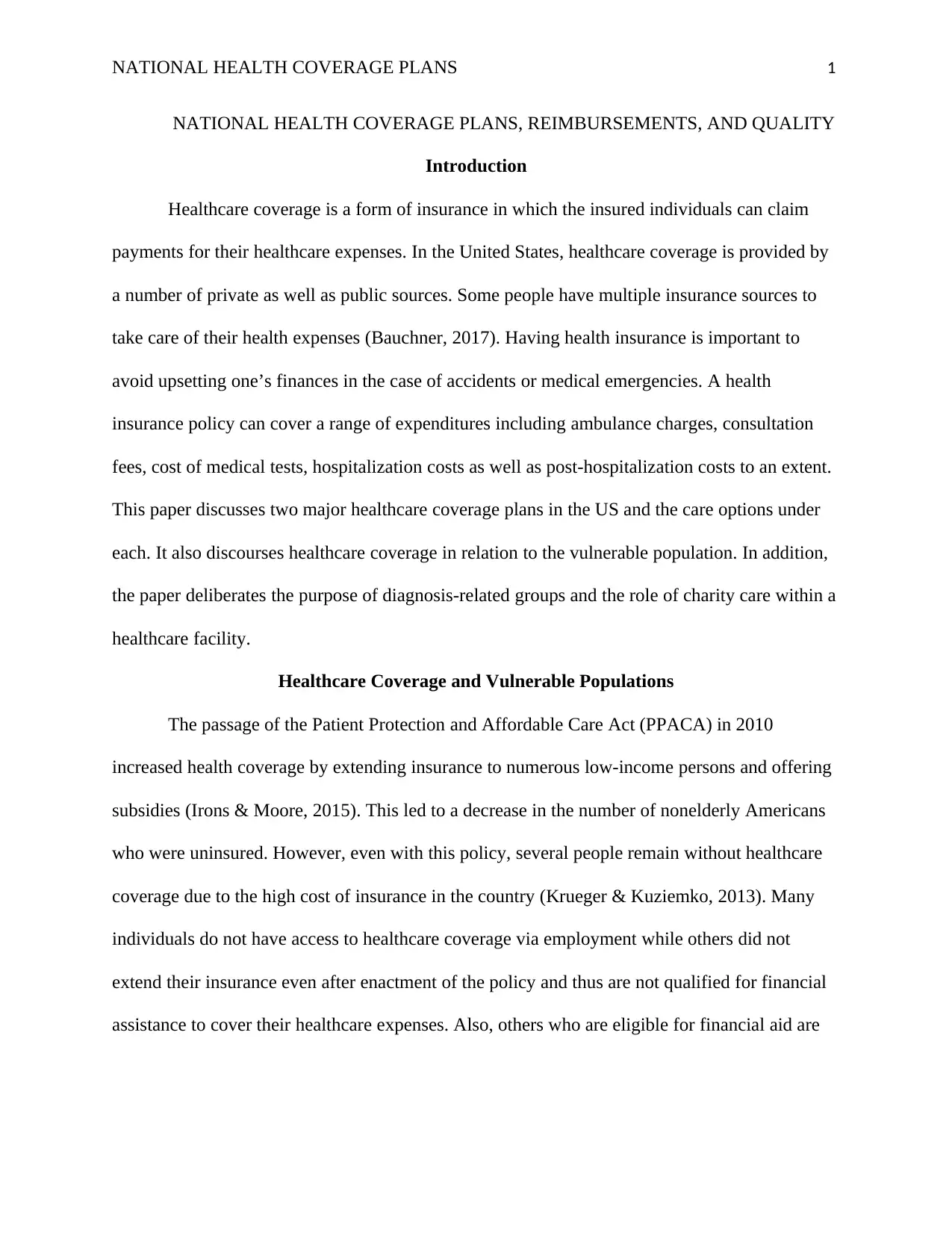
NATIONAL HEALTH COVERAGE PLANS 1
NATIONAL HEALTH COVERAGE PLANS, REIMBURSEMENTS, AND QUALITY
Introduction
Healthcare coverage is a form of insurance in which the insured individuals can claim
payments for their healthcare expenses. In the United States, healthcare coverage is provided by
a number of private as well as public sources. Some people have multiple insurance sources to
take care of their health expenses (Bauchner, 2017). Having health insurance is important to
avoid upsetting one’s finances in the case of accidents or medical emergencies. A health
insurance policy can cover a range of expenditures including ambulance charges, consultation
fees, cost of medical tests, hospitalization costs as well as post-hospitalization costs to an extent.
This paper discusses two major healthcare coverage plans in the US and the care options under
each. It also discourses healthcare coverage in relation to the vulnerable population. In addition,
the paper deliberates the purpose of diagnosis-related groups and the role of charity care within a
healthcare facility.
Healthcare Coverage and Vulnerable Populations
The passage of the Patient Protection and Affordable Care Act (PPACA) in 2010
increased health coverage by extending insurance to numerous low-income persons and offering
subsidies (Irons & Moore, 2015). This led to a decrease in the number of nonelderly Americans
who were uninsured. However, even with this policy, several people remain without healthcare
coverage due to the high cost of insurance in the country (Krueger & Kuziemko, 2013). Many
individuals do not have access to healthcare coverage via employment while others did not
extend their insurance even after enactment of the policy and thus are not qualified for financial
assistance to cover their healthcare expenses. Also, others who are eligible for financial aid are
NATIONAL HEALTH COVERAGE PLANS, REIMBURSEMENTS, AND QUALITY
Introduction
Healthcare coverage is a form of insurance in which the insured individuals can claim
payments for their healthcare expenses. In the United States, healthcare coverage is provided by
a number of private as well as public sources. Some people have multiple insurance sources to
take care of their health expenses (Bauchner, 2017). Having health insurance is important to
avoid upsetting one’s finances in the case of accidents or medical emergencies. A health
insurance policy can cover a range of expenditures including ambulance charges, consultation
fees, cost of medical tests, hospitalization costs as well as post-hospitalization costs to an extent.
This paper discusses two major healthcare coverage plans in the US and the care options under
each. It also discourses healthcare coverage in relation to the vulnerable population. In addition,
the paper deliberates the purpose of diagnosis-related groups and the role of charity care within a
healthcare facility.
Healthcare Coverage and Vulnerable Populations
The passage of the Patient Protection and Affordable Care Act (PPACA) in 2010
increased health coverage by extending insurance to numerous low-income persons and offering
subsidies (Irons & Moore, 2015). This led to a decrease in the number of nonelderly Americans
who were uninsured. However, even with this policy, several people remain without healthcare
coverage due to the high cost of insurance in the country (Krueger & Kuziemko, 2013). Many
individuals do not have access to healthcare coverage via employment while others did not
extend their insurance even after enactment of the policy and thus are not qualified for financial
assistance to cover their healthcare expenses. Also, others who are eligible for financial aid are
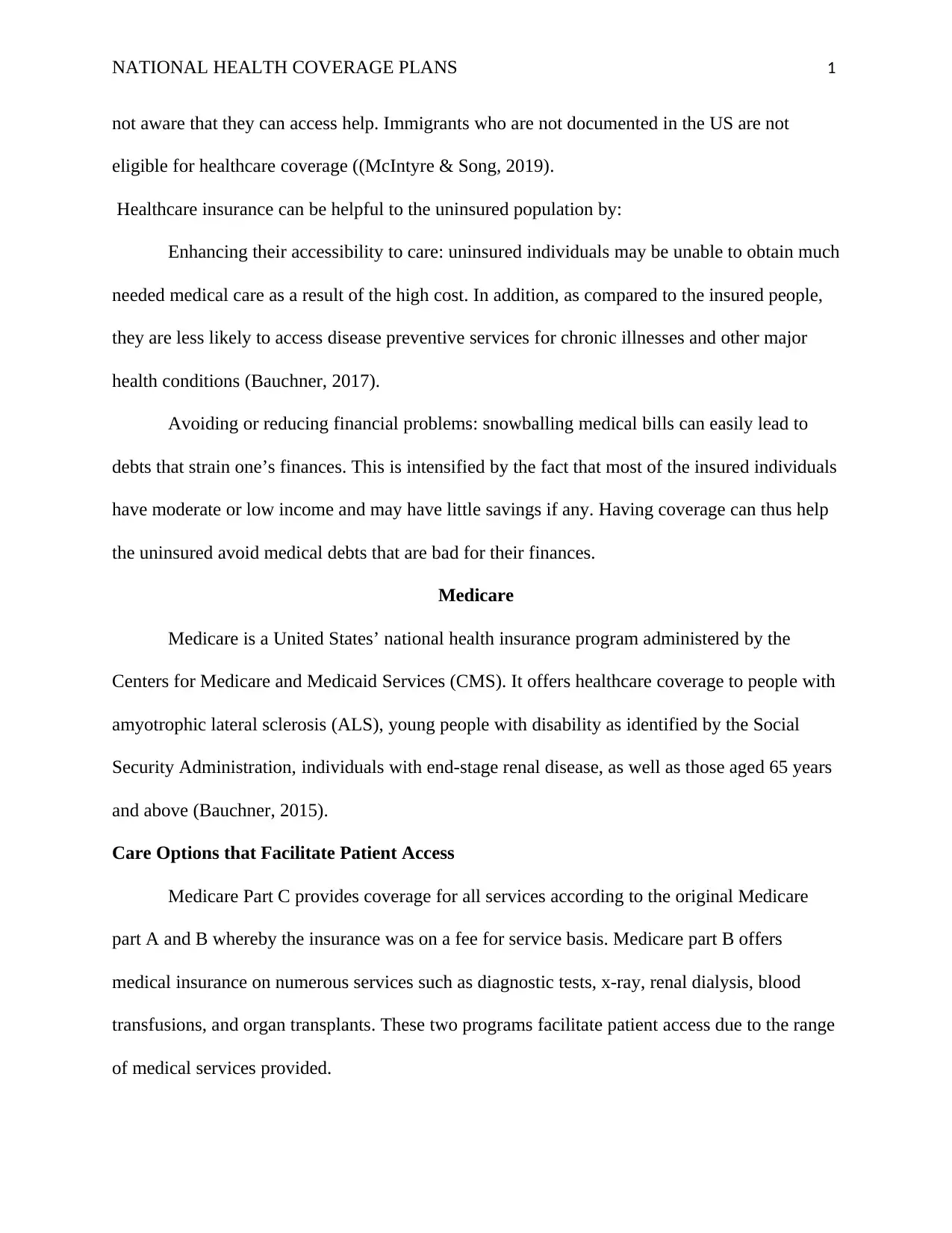
NATIONAL HEALTH COVERAGE PLANS 1
not aware that they can access help. Immigrants who are not documented in the US are not
eligible for healthcare coverage ((McIntyre & Song, 2019).
Healthcare insurance can be helpful to the uninsured population by:
Enhancing their accessibility to care: uninsured individuals may be unable to obtain much
needed medical care as a result of the high cost. In addition, as compared to the insured people,
they are less likely to access disease preventive services for chronic illnesses and other major
health conditions (Bauchner, 2017).
Avoiding or reducing financial problems: snowballing medical bills can easily lead to
debts that strain one’s finances. This is intensified by the fact that most of the insured individuals
have moderate or low income and may have little savings if any. Having coverage can thus help
the uninsured avoid medical debts that are bad for their finances.
Medicare
Medicare is a United States’ national health insurance program administered by the
Centers for Medicare and Medicaid Services (CMS). It offers healthcare coverage to people with
amyotrophic lateral sclerosis (ALS), young people with disability as identified by the Social
Security Administration, individuals with end-stage renal disease, as well as those aged 65 years
and above (Bauchner, 2015).
Care Options that Facilitate Patient Access
Medicare Part C provides coverage for all services according to the original Medicare
part A and B whereby the insurance was on a fee for service basis. Medicare part B offers
medical insurance on numerous services such as diagnostic tests, x-ray, renal dialysis, blood
transfusions, and organ transplants. These two programs facilitate patient access due to the range
of medical services provided.
not aware that they can access help. Immigrants who are not documented in the US are not
eligible for healthcare coverage ((McIntyre & Song, 2019).
Healthcare insurance can be helpful to the uninsured population by:
Enhancing their accessibility to care: uninsured individuals may be unable to obtain much
needed medical care as a result of the high cost. In addition, as compared to the insured people,
they are less likely to access disease preventive services for chronic illnesses and other major
health conditions (Bauchner, 2017).
Avoiding or reducing financial problems: snowballing medical bills can easily lead to
debts that strain one’s finances. This is intensified by the fact that most of the insured individuals
have moderate or low income and may have little savings if any. Having coverage can thus help
the uninsured avoid medical debts that are bad for their finances.
Medicare
Medicare is a United States’ national health insurance program administered by the
Centers for Medicare and Medicaid Services (CMS). It offers healthcare coverage to people with
amyotrophic lateral sclerosis (ALS), young people with disability as identified by the Social
Security Administration, individuals with end-stage renal disease, as well as those aged 65 years
and above (Bauchner, 2015).
Care Options that Facilitate Patient Access
Medicare Part C provides coverage for all services according to the original Medicare
part A and B whereby the insurance was on a fee for service basis. Medicare part B offers
medical insurance on numerous services such as diagnostic tests, x-ray, renal dialysis, blood
transfusions, and organ transplants. These two programs facilitate patient access due to the range
of medical services provided.
⊘ This is a preview!⊘
Do you want full access?
Subscribe today to unlock all pages.

Trusted by 1+ million students worldwide
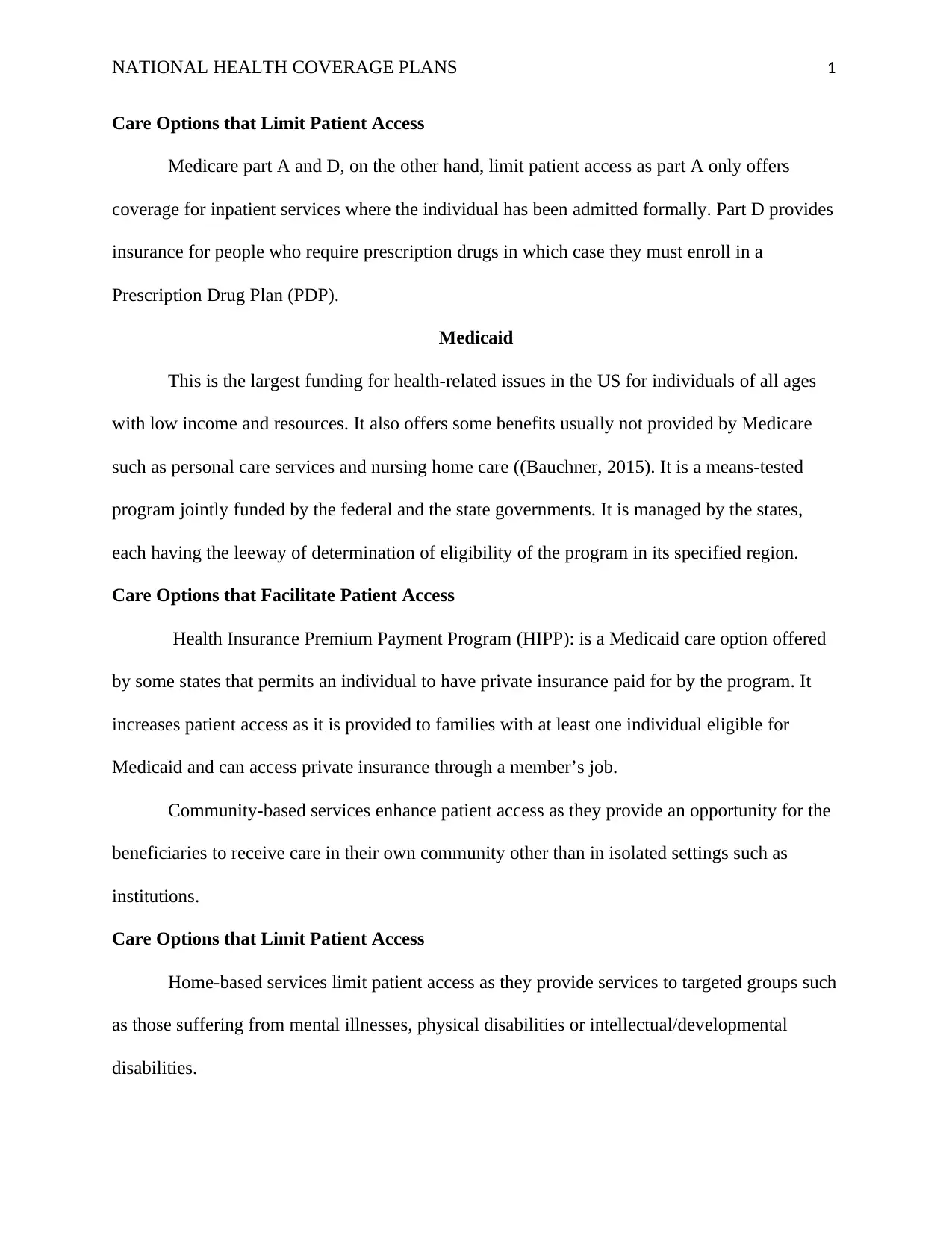
NATIONAL HEALTH COVERAGE PLANS 1
Care Options that Limit Patient Access
Medicare part A and D, on the other hand, limit patient access as part A only offers
coverage for inpatient services where the individual has been admitted formally. Part D provides
insurance for people who require prescription drugs in which case they must enroll in a
Prescription Drug Plan (PDP).
Medicaid
This is the largest funding for health-related issues in the US for individuals of all ages
with low income and resources. It also offers some benefits usually not provided by Medicare
such as personal care services and nursing home care ((Bauchner, 2015). It is a means-tested
program jointly funded by the federal and the state governments. It is managed by the states,
each having the leeway of determination of eligibility of the program in its specified region.
Care Options that Facilitate Patient Access
Health Insurance Premium Payment Program (HIPP): is a Medicaid care option offered
by some states that permits an individual to have private insurance paid for by the program. It
increases patient access as it is provided to families with at least one individual eligible for
Medicaid and can access private insurance through a member’s job.
Community-based services enhance patient access as they provide an opportunity for the
beneficiaries to receive care in their own community other than in isolated settings such as
institutions.
Care Options that Limit Patient Access
Home-based services limit patient access as they provide services to targeted groups such
as those suffering from mental illnesses, physical disabilities or intellectual/developmental
disabilities.
Care Options that Limit Patient Access
Medicare part A and D, on the other hand, limit patient access as part A only offers
coverage for inpatient services where the individual has been admitted formally. Part D provides
insurance for people who require prescription drugs in which case they must enroll in a
Prescription Drug Plan (PDP).
Medicaid
This is the largest funding for health-related issues in the US for individuals of all ages
with low income and resources. It also offers some benefits usually not provided by Medicare
such as personal care services and nursing home care ((Bauchner, 2015). It is a means-tested
program jointly funded by the federal and the state governments. It is managed by the states,
each having the leeway of determination of eligibility of the program in its specified region.
Care Options that Facilitate Patient Access
Health Insurance Premium Payment Program (HIPP): is a Medicaid care option offered
by some states that permits an individual to have private insurance paid for by the program. It
increases patient access as it is provided to families with at least one individual eligible for
Medicaid and can access private insurance through a member’s job.
Community-based services enhance patient access as they provide an opportunity for the
beneficiaries to receive care in their own community other than in isolated settings such as
institutions.
Care Options that Limit Patient Access
Home-based services limit patient access as they provide services to targeted groups such
as those suffering from mental illnesses, physical disabilities or intellectual/developmental
disabilities.
Paraphrase This Document
Need a fresh take? Get an instant paraphrase of this document with our AI Paraphraser
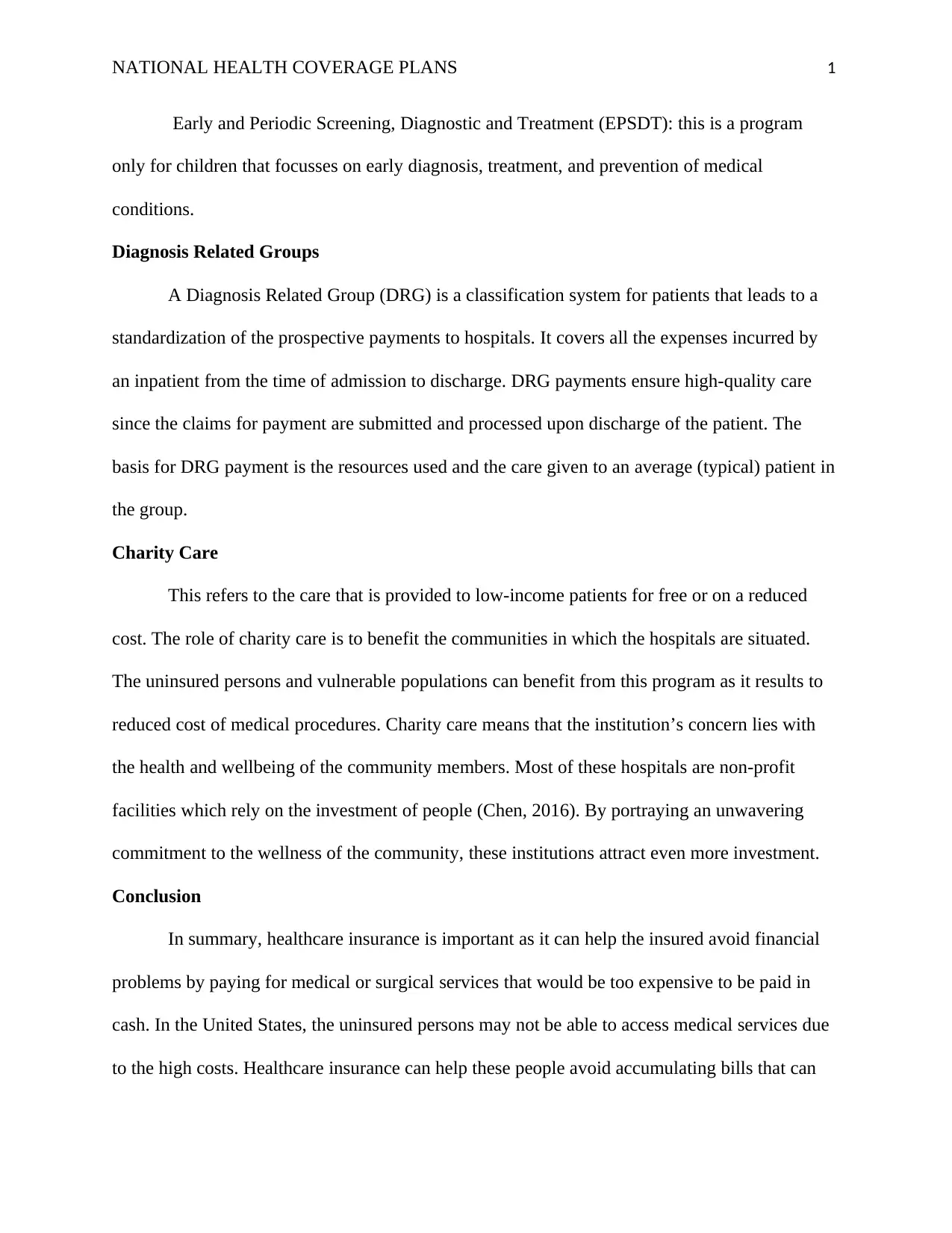
NATIONAL HEALTH COVERAGE PLANS 1
Early and Periodic Screening, Diagnostic and Treatment (EPSDT): this is a program
only for children that focusses on early diagnosis, treatment, and prevention of medical
conditions.
Diagnosis Related Groups
A Diagnosis Related Group (DRG) is a classification system for patients that leads to a
standardization of the prospective payments to hospitals. It covers all the expenses incurred by
an inpatient from the time of admission to discharge. DRG payments ensure high-quality care
since the claims for payment are submitted and processed upon discharge of the patient. The
basis for DRG payment is the resources used and the care given to an average (typical) patient in
the group.
Charity Care
This refers to the care that is provided to low-income patients for free or on a reduced
cost. The role of charity care is to benefit the communities in which the hospitals are situated.
The uninsured persons and vulnerable populations can benefit from this program as it results to
reduced cost of medical procedures. Charity care means that the institution’s concern lies with
the health and wellbeing of the community members. Most of these hospitals are non-profit
facilities which rely on the investment of people (Chen, 2016). By portraying an unwavering
commitment to the wellness of the community, these institutions attract even more investment.
Conclusion
In summary, healthcare insurance is important as it can help the insured avoid financial
problems by paying for medical or surgical services that would be too expensive to be paid in
cash. In the United States, the uninsured persons may not be able to access medical services due
to the high costs. Healthcare insurance can help these people avoid accumulating bills that can
Early and Periodic Screening, Diagnostic and Treatment (EPSDT): this is a program
only for children that focusses on early diagnosis, treatment, and prevention of medical
conditions.
Diagnosis Related Groups
A Diagnosis Related Group (DRG) is a classification system for patients that leads to a
standardization of the prospective payments to hospitals. It covers all the expenses incurred by
an inpatient from the time of admission to discharge. DRG payments ensure high-quality care
since the claims for payment are submitted and processed upon discharge of the patient. The
basis for DRG payment is the resources used and the care given to an average (typical) patient in
the group.
Charity Care
This refers to the care that is provided to low-income patients for free or on a reduced
cost. The role of charity care is to benefit the communities in which the hospitals are situated.
The uninsured persons and vulnerable populations can benefit from this program as it results to
reduced cost of medical procedures. Charity care means that the institution’s concern lies with
the health and wellbeing of the community members. Most of these hospitals are non-profit
facilities which rely on the investment of people (Chen, 2016). By portraying an unwavering
commitment to the wellness of the community, these institutions attract even more investment.
Conclusion
In summary, healthcare insurance is important as it can help the insured avoid financial
problems by paying for medical or surgical services that would be too expensive to be paid in
cash. In the United States, the uninsured persons may not be able to access medical services due
to the high costs. Healthcare insurance can help these people avoid accumulating bills that can
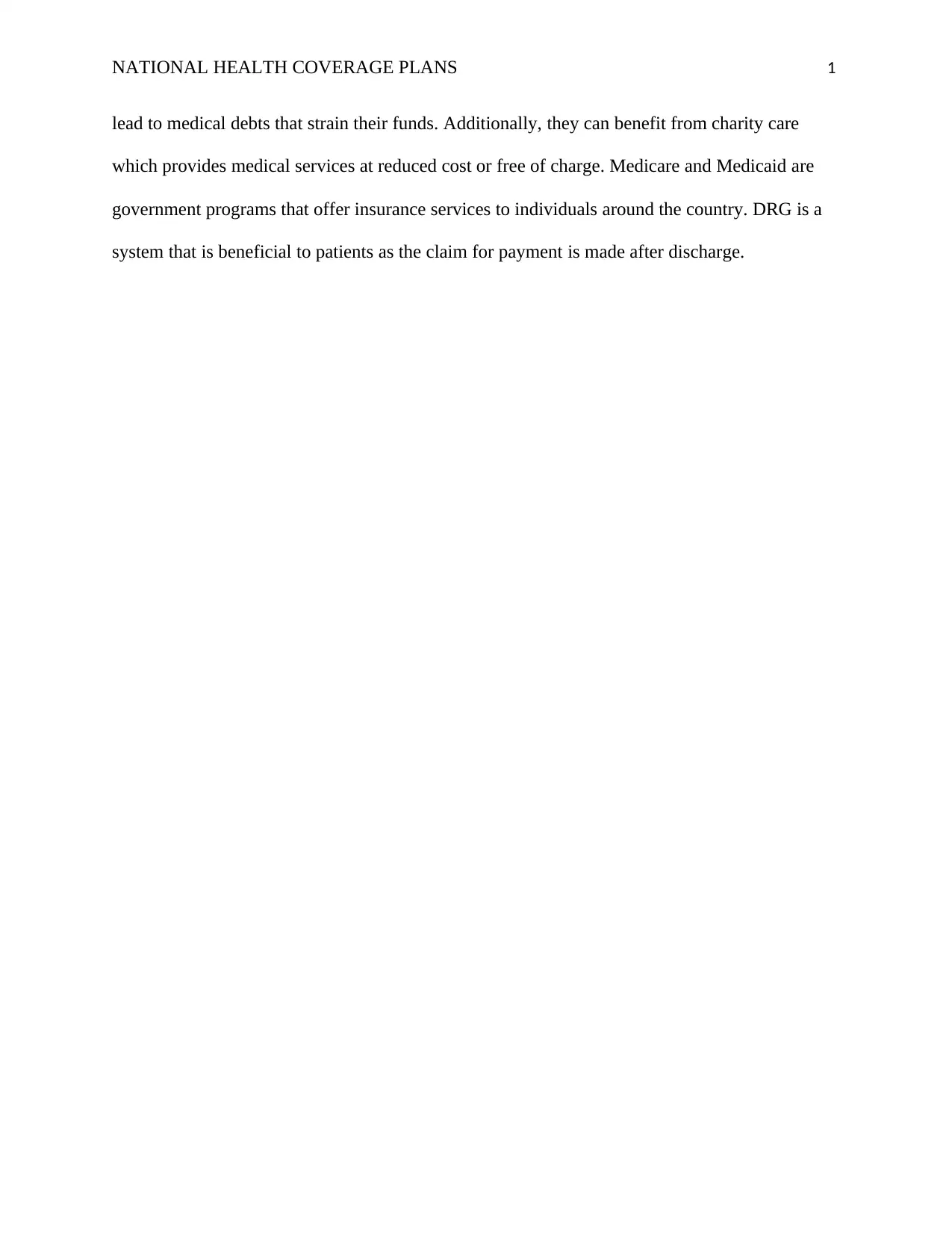
NATIONAL HEALTH COVERAGE PLANS 1
lead to medical debts that strain their funds. Additionally, they can benefit from charity care
which provides medical services at reduced cost or free of charge. Medicare and Medicaid are
government programs that offer insurance services to individuals around the country. DRG is a
system that is beneficial to patients as the claim for payment is made after discharge.
lead to medical debts that strain their funds. Additionally, they can benefit from charity care
which provides medical services at reduced cost or free of charge. Medicare and Medicaid are
government programs that offer insurance services to individuals around the country. DRG is a
system that is beneficial to patients as the claim for payment is made after discharge.
⊘ This is a preview!⊘
Do you want full access?
Subscribe today to unlock all pages.

Trusted by 1+ million students worldwide
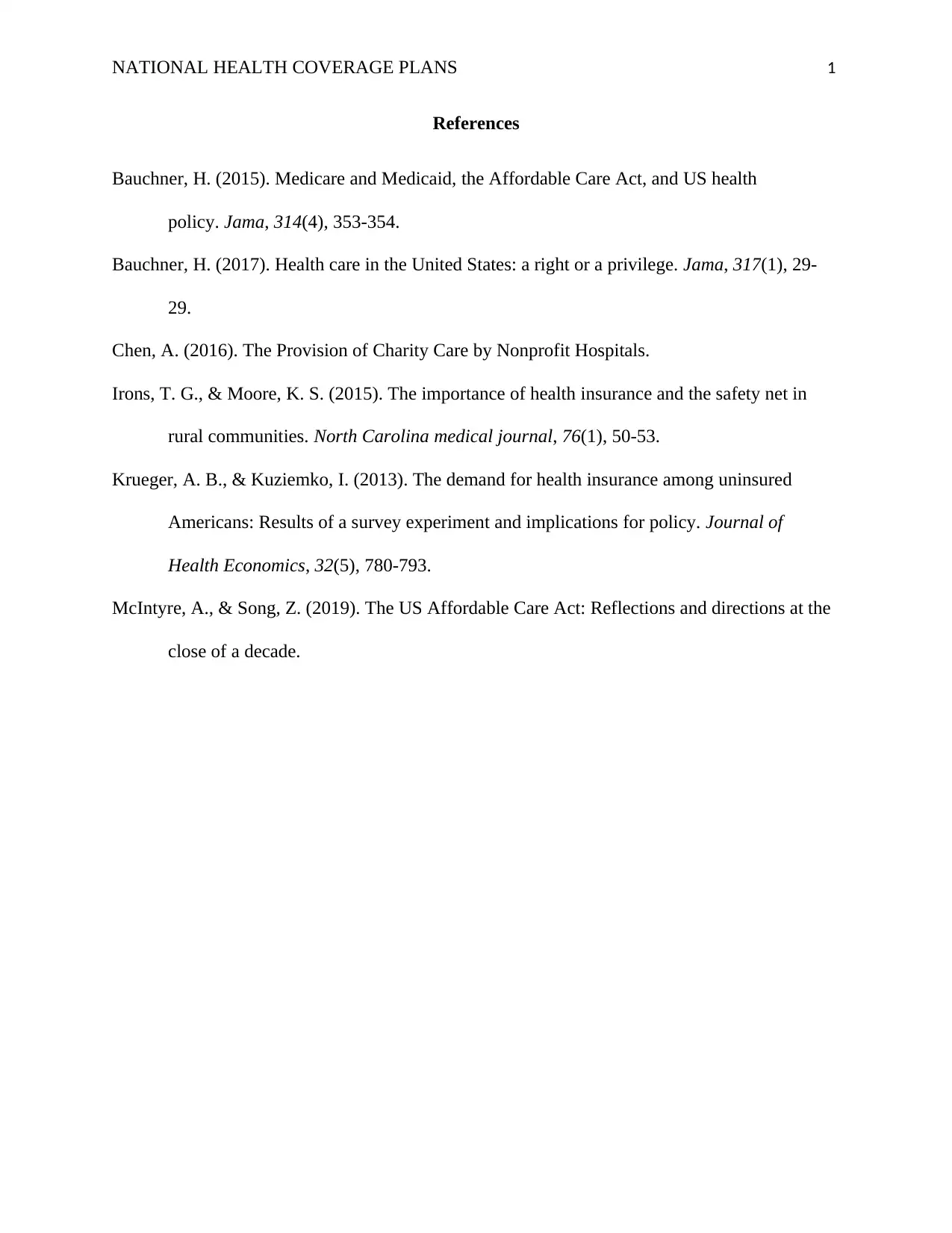
NATIONAL HEALTH COVERAGE PLANS 1
References
Bauchner, H. (2015). Medicare and Medicaid, the Affordable Care Act, and US health
policy. Jama, 314(4), 353-354.
Bauchner, H. (2017). Health care in the United States: a right or a privilege. Jama, 317(1), 29-
29.
Chen, A. (2016). The Provision of Charity Care by Nonprofit Hospitals.
Irons, T. G., & Moore, K. S. (2015). The importance of health insurance and the safety net in
rural communities. North Carolina medical journal, 76(1), 50-53.
Krueger, A. B., & Kuziemko, I. (2013). The demand for health insurance among uninsured
Americans: Results of a survey experiment and implications for policy. Journal of
Health Economics, 32(5), 780-793.
McIntyre, A., & Song, Z. (2019). The US Affordable Care Act: Reflections and directions at the
close of a decade.
References
Bauchner, H. (2015). Medicare and Medicaid, the Affordable Care Act, and US health
policy. Jama, 314(4), 353-354.
Bauchner, H. (2017). Health care in the United States: a right or a privilege. Jama, 317(1), 29-
29.
Chen, A. (2016). The Provision of Charity Care by Nonprofit Hospitals.
Irons, T. G., & Moore, K. S. (2015). The importance of health insurance and the safety net in
rural communities. North Carolina medical journal, 76(1), 50-53.
Krueger, A. B., & Kuziemko, I. (2013). The demand for health insurance among uninsured
Americans: Results of a survey experiment and implications for policy. Journal of
Health Economics, 32(5), 780-793.
McIntyre, A., & Song, Z. (2019). The US Affordable Care Act: Reflections and directions at the
close of a decade.
1 out of 7
Related Documents
Your All-in-One AI-Powered Toolkit for Academic Success.
+13062052269
info@desklib.com
Available 24*7 on WhatsApp / Email
![[object Object]](/_next/static/media/star-bottom.7253800d.svg)
Unlock your academic potential
Copyright © 2020–2025 A2Z Services. All Rights Reserved. Developed and managed by ZUCOL.




